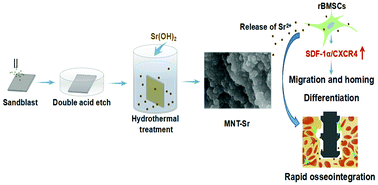当前位置:
X-MOL 学术
›
Biomater. Sci.
›
论文详情
Our official English website, www.x-mol.net, welcomes your
feedback! (Note: you will need to create a separate account there.)
The effects of Sr-incorporated micro/nano rough titanium surface on rBMSC migration and osteogenic differentiation for rapid osteointegration
Biomaterials Science ( IF 5.8 ) Pub Date : 2018-05-16 00:00:00 , DOI: 10.1039/c8bm00473k Chuan Zhou 1, 2, 3, 4, 5 , An-tian Xu 1, 2, 3, 4, 5 , Dan-dan Wang 1, 2, 3, 4, 5 , Guo-fen Lin 2, 3, 4, 5, 6 , Tie Liu 2, 3, 4, 5, 7 , Fu-ming He 1, 2, 3, 4, 5
Biomaterials Science ( IF 5.8 ) Pub Date : 2018-05-16 00:00:00 , DOI: 10.1039/c8bm00473k Chuan Zhou 1, 2, 3, 4, 5 , An-tian Xu 1, 2, 3, 4, 5 , Dan-dan Wang 1, 2, 3, 4, 5 , Guo-fen Lin 2, 3, 4, 5, 6 , Tie Liu 2, 3, 4, 5, 7 , Fu-ming He 1, 2, 3, 4, 5
Affiliation

|
Recruitment of endogenous bone marrow-derived mesenchymal stem cells (BMSCs) has been widely discussed as an alternative strategy for bone regeneration. Strontium (Sr) is known to direct the BMSCs’ commitment to the bone lineage and encourage bone formation; however, the underlying mechanisms remain elusive. In this study, an Sr-incorporated micro/nano rough titanium surface (MNT-Sr) was fabricated by hydrothermal treatment in an attempt to facilitate BMSCs’ recruitment and their osteogenic differentiation to enhance rapid osseointegration. Micro rough titanium (MT) was set as the control biomaterial. In vitro, MNT-Sr and its extracts promoted the migration and osteogenic differentiation of BMSCs. In animal studies, green fluorescent protein (GFP)-labeled BMSCs were intravenously injected into wild-type rats for tracing before tibial implantation surgery. The GFP+BMSC recruitment to the implantation site was successfully triggered by MNT-Sr implantation. A trend for increased bone area (BA%), bone–implant contact (BIC%) and removal torque values (RTVs) was observed for the MNT-Sr implant compared to that observed for MT at 2 weeks. Advanced mechanism analysis indicated that Sr2+ enhanced the SDF-1α/CXCR4 signaling pathway both in vitro and in vivo. Taken together, these findings suggest that MNT-Sr has promising therapeutic potential for future use in dental implants by homing endogenous stem cells to stimulate bone regeneration.
中文翻译:

掺Sr的微米/纳米粗糙钛表面对rBMSC迁移和成骨分化以快速骨整合的影响
招募内源性骨髓间充质干细胞(BMSCs)作为骨再生的另一种策略已被广泛讨论。锶(Sr)可以引导BMSC致力于骨骼,并促进骨骼的形成。但是,基本机制仍然难以捉摸。在这项研究中,通过水热处理制备了掺有Sr的微/纳米粗糙钛表面(MNT-Sr),以促进BMSC的募集及其成骨分化,以增强快速的骨整合。将微粗钛(MT)设置为对照生物材料。体外,MNT-Sr及其提取物促进了BMSCs的迁移和成骨分化。在动物研究中,在胫骨植入手术之前,将绿色荧光蛋白(GFP)标记的BMSC静脉注射到野生型大鼠中进行追踪。MNT-Sr植入成功触发了GFP + BMSC募集到植入位点。与2周MT观察到的相比,MNT-Sr植入物观察到了增加的骨面积(BA%),骨-植入物接触(BIC%)和去除扭矩值(RTVs)的趋势。先进机制分析表明,锶2+增强了SDF-1α/ CXCR4信号传导途径二者在体外和体内。综上所述,这些发现表明,MNT-Sr通过归巢内源性干细胞刺激骨再生,在牙科植入物中具有广阔的应用前景。
更新日期:2018-05-16
中文翻译:

掺Sr的微米/纳米粗糙钛表面对rBMSC迁移和成骨分化以快速骨整合的影响
招募内源性骨髓间充质干细胞(BMSCs)作为骨再生的另一种策略已被广泛讨论。锶(Sr)可以引导BMSC致力于骨骼,并促进骨骼的形成。但是,基本机制仍然难以捉摸。在这项研究中,通过水热处理制备了掺有Sr的微/纳米粗糙钛表面(MNT-Sr),以促进BMSC的募集及其成骨分化,以增强快速的骨整合。将微粗钛(MT)设置为对照生物材料。体外,MNT-Sr及其提取物促进了BMSCs的迁移和成骨分化。在动物研究中,在胫骨植入手术之前,将绿色荧光蛋白(GFP)标记的BMSC静脉注射到野生型大鼠中进行追踪。MNT-Sr植入成功触发了GFP + BMSC募集到植入位点。与2周MT观察到的相比,MNT-Sr植入物观察到了增加的骨面积(BA%),骨-植入物接触(BIC%)和去除扭矩值(RTVs)的趋势。先进机制分析表明,锶2+增强了SDF-1α/ CXCR4信号传导途径二者在体外和体内。综上所述,这些发现表明,MNT-Sr通过归巢内源性干细胞刺激骨再生,在牙科植入物中具有广阔的应用前景。











































 京公网安备 11010802027423号
京公网安备 11010802027423号